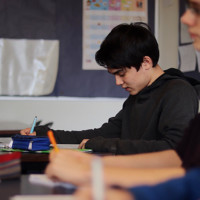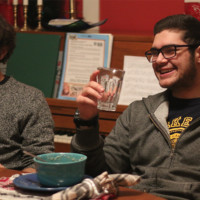“While We Wait”
In her most recent release, Kehlani reveals her relationship experiences with a passionate and unapologetic quality.

On Feb. 21 of this year, American singer and songwriter Kehlani eased fans’ growing anticipation for new music with the release of her fourth project, “While We Wait.”
Kehlani Parrish, known simply by her first name, gained success in 2017 after releasing her breakout record, “SweetSexySavage.” The album identified Parrish as a true artist who creates empowering music, and left listeners hopeful for more of her soulful mixture of pop and R&B.
“While We Wait” continues this theme of empowerment as Parrish navigates through her experiences both in romantic relationships and the lessons she has learned from them. She builds the story through the consistent underlying themes of her keen sense of self-love and understanding of self-worth, mentioning unrealistic standards and insecurity.
The project — whose title is a reference to Parrish’s recent pregnancy — is meant as a gift to her newborn daughter that will teach her how to combat the negative impacts of society, according to a review by online publication Nest HQ.
Parrish introduces the album by diving headfirst into the vulnerable lyrics of “Footsteps,” featuring singer Musiq Soulchild. The addition of his voice in the first track immediately allows
the listener to understand the message of the song: the importance of honesty and communication in a healthy relationship. Soulchild’s performance is strong in content but a little lackluster in intensity. The lyrics, “But still, cheers to being honest / Neither of us knew what we wanted, no,” enforce the strength of honesty in a relationship, even if other aspects of the relationship are rocky.
The next song, “Too Deep,” explores the idea of an overwhelmingly complicated relationship in a bubbly, upbeat tone. Parrish emphasizes the feeling of being in over her head by repeatedly singing the word “too.”
“Too Deep” acts as a transition into the bright tone and emotions of the coming songs: “Nunya,” featuring Dom Kennedy, and “Morning Glory.” Through these songs, Parrish’s powerful sense of self begins to flourish more than in the first two tracks, and the listener can’t help but feel that this is intentional.
“Nunya” begins with a smooth melody, which is soon accompanied by a soft beat and Parrish’s lyrics. Throughout the song, Parrish sings about the different lives lived by two people who are no longer in a relationship, and this theme is especially apparent in the chorus: “Ain’t nunya business / To know who I’m with / Oh, none of my s—.” Parrish is straight to the point.
Parrish’s lesson to her daughter becomes clearer as each song reveals a vital aspect of a healthy relationship. Considering the content of every track, the specific placement of the songs seems to create a cohesive story. As the listener goes through the songs in order, they build on each other to reveal the bigger picture: Parrish’s message of self-love and worth through adversity that can be present within relationships.
In “Nights Like This,” featuring Ty Dolla $ign, Parrish shares the heartbreak and painful moments in her relationships. If “While We Wait” is a narrative, “Nights Like This” is the moment of turmoil. Once again, the collaboration and use of a different voice creates a powerful layer and re-enforces the concept of a relationship. With a more pop-like tone and a quicker beat, Parrish and Ty Dolla $ign raise feelings of anger and nostalgia, as they sing about missing someone: “You took my feelings and just threw ‘em out the window / Feel like it’s too hard to fall in love again, no / On some nights like this, shawty, I can’t help but think of us.”
As she wraps up the project with “Love Language,” Parrish backtracks to the themes in the first song, singing about the strength of healthy communication. Yet this time, the experience is foreign and exciting, rather than the exasperated tone of “Footsteps.” “I don’t speak your language / But I wanna know more baby,” she sings. This connection between the opening and closing tracks emphasizes Parrish’s growth and changing perspective on relationships.
Although all of the tracks are catchy and highlight Parrish’s spectacular vocals, the production lacks differentiation in sound. While there is an alternation between slower and upbeat tempos and a mix of songs that lean toward either a pop or R&B feel, there seems to be an absence of individuality between tracks. This could be considered as another layer to the consistent narrative, yet it is not necessarily enjoyable for the listener. Fortunately, the production doesn’t take away from the overall intentions of the album.
The thematic aspects successfully remain cohesive and purposeful throughout the entirety of “While We Wait” and combine to create a beautiful and meaningful story for Parrish’s daughter. The featured artists contribute to the idea of navigating relationships, and the usage of alternating voices make the intent of the record all the more pronounced.
Throughout the album, Parrish seamlessly ties each song to the value of self within relationships by focusing on positive reflections, which is even hinted at in the album cover: a reflection of Parrish’s face in a mirror.
– Review by Haley Koski and illustration by Sophia Date
“Kim Possible” film
The remake of a popular childhood TV show is nothing more than an ersatz of the original.

The 2019 live-action remake of the early 2000s cartoon show, “Kim Possible,” feels like a cheap knock-off. The acting and fight scenes are poorly done, and the special effects and CGI are equally atrocious. The attempts to revamp the incredibly popular cartoon has instead ruined the reputation of the entire franchise.
From 2002 to 2007, the “Kim Possible” television show aired on Disney Channel, tracking the lives of high school students Kim Possible and her best friend, Ron Stoppable. Together, the two balance high school, social lives and saving the world.
From the opening scene, the film’s poor execution is obvious. Kim Possible (Sadie Stanley) and Ron Stoppable (Sean Giambrone) fly into the scene on jet packs, with the green-screened sky visible in the background. You will want to look away as it plays out; it is almost painful to watch. The first villain the pair meets has a tacky, unidentifiable accent and boasts of the lethal slime that he has created. As the camera pans to this “slime,” it looks like something out of “Sharkboy and Lavagirl,” a movie from the early 2000s with similarly low production quality.
This awful five-minute scene is the closest the “Kim Possible” movie comes to replicating the action and appeal of the animated series. As the film continues, it does the seemingly impossible: It gets even worse.
Firstly, the entire film was extremely inaccurate. Several scenes completely change significant details from the show. Kim Possible’s age, friends and iconic equipment, such as her pager, are all different in this live action movie. These inaccuracies feed into the subpar production of the film, exacerbating the pre-existing issues.
Additionally, Stanley’s portrayal of Kim Possible is not remotely close to the animated show, coming off as annoying and making the movie even more uncomfortable to watch. The dialogue between Stanley and others is awkward and many of her lines are melodramatic.
One particular scene emphasizes the poor acting and will likely stick uncomfortably in a viewer’s mind. Dr. Drakken — the film’s main antagonist — is attempting to kidnap Athena, a new girl at Kim Possible’s high school who has quickly gained popularity. Kim Possible sees the attempted kidnapping as a chance to prove she’s better than Athena. But by trying to save her, Kim Possible allows Athena’s abduction. Kim Possible ends up hurting herself and becomes the laughingstock of the school.
The concept is exaggerated to begin with, but the acting worsens this already poorly executed scene. Stanley’s line delivery and blocking are overly theatrical and take away from the scene rather than enhance it.
Though the acting and plot are both abysmal, as can be seen within a few minutes, the film’s primary issue is the production.
The directors try to emulate a fight scene as it would appear in the cartoon, but viewing these scenes with real actors is exceptionally cheesy.
Another cringe-inducing flaw worth mentioning is the movie’s attempt to keep up-to-date with current trends and technologies. Kim Possible’s iconic pager is changed to a necklace, which looks cheap and child-like, and all of her equipment is plastic and shiny. Dr. Drakken has an iPhone, and uses the poorly-named “Villinstagram” to post about his plans, Ron Stoppable live-streams all of his school days, and the words “FOMO” and “duck face” are thrown in often. When remaking a show whose former viewers are now in their late teens or early 20s, it is essential to integrate concepts that would appeal to new and older audiences. However, the film combines these two very different generations unsuccessfully, ruining its potential.
With the live action version of “Kim Possible,” Disney had the opportunity to create an entertaining film, filled with nostalgia, that could have appealed to both teenagers and children. However, the movie misses the mark, and it isn’t worth suffering through 86 minutes for only a few seconds of relived memories.
– Review and illustration by Sophia Date




